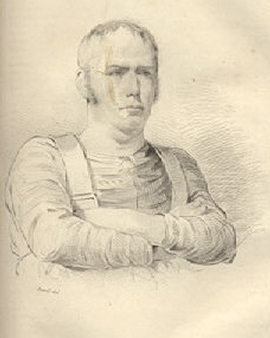


Ambroise Louis Garneray's life was certainly not one thing: boring. Born in Paris in 1783, the Frenchman was not only an artist, but also an engraver, naval officer, privateer and writer. Due to his forceful character and a way of life that was not only characterized by morality and charity, he was already controversial as a person during his lifetime.
His love of the sea, however, was probably the most formative for Garneray and it runs through both his artistic work and his life, from early childhood on. At the age of only 13, Ambroise Louis Garneray decided to enlist in the French Navy. His father, Jean-François Garneray, who was also devoted to painting and who had been a student of Jacques-Louis David, let his son go. His first voyages with the navy took the young Ambroise Louis Garneray to the Indian Ocean, where France repeatedly engaged in fierce battles with British war fleets. Garneray took part in naval battles and was shipwrecked several times, but without ever being seriously injured. More and more Garneray was drawn to the dark side of naval life. For several years he earned his living as a privateer and slave trader until his ship was captured by the British in 1806 and he became a prisoner of war.
He then spent eight years in captivity in the English port city of Portsmouth. While serving the time, he began to devote himself intensively to painting. Almost all of his works are maritime, depicting life and death at sea. His style is detailed and clear, yet the works do not lose their spirit of adventure by being too clearly realistic. Oil paintings were Garneray's preferred form of painting, but his legacy also includes numerous copperplate engravings. His work tells of adventures at sea, but also of hardship and naval warfare. Ships and boats, which naturally play a major role in his artwork, are drawn with an attention to detail rarely found.
After his time in captivity, Ambroise Louis Garneray returned to France where he was appointed "Peintre du Duc d'Angoulême, grand amiral d France". This meant he was henceforth the official painter of the then admiral of France, Louis-Antoine de Bourbon, duc d'Angoulême. For Garneray, who throughout his life had been marked by a fascination with the military, this appointment was a great honor and a position he gratefully accepted. The artist increasingly translated the power of his paintings into the written word. As a writer, Garneray also enjoyed success. However, not until several decades after his death. To this day, his works are exhibited in numerous important museums, especially in France. He is one of the most successful and best-known marine painters of all time and left a lasting mark on the genre. Many artists after him also made his clear and distinctive style their own.

Ambroise Louis Garneray's life was certainly not one thing: boring. Born in Paris in 1783, the Frenchman was not only an artist, but also an engraver, naval officer, privateer and writer. Due to his forceful character and a way of life that was not only characterized by morality and charity, he was already controversial as a person during his lifetime.
His love of the sea, however, was probably the most formative for Garneray and it runs through both his artistic work and his life, from early childhood on. At the age of only 13, Ambroise Louis Garneray decided to enlist in the French Navy. His father, Jean-François Garneray, who was also devoted to painting and who had been a student of Jacques-Louis David, let his son go. His first voyages with the navy took the young Ambroise Louis Garneray to the Indian Ocean, where France repeatedly engaged in fierce battles with British war fleets. Garneray took part in naval battles and was shipwrecked several times, but without ever being seriously injured. More and more Garneray was drawn to the dark side of naval life. For several years he earned his living as a privateer and slave trader until his ship was captured by the British in 1806 and he became a prisoner of war.
He then spent eight years in captivity in the English port city of Portsmouth. While serving the time, he began to devote himself intensively to painting. Almost all of his works are maritime, depicting life and death at sea. His style is detailed and clear, yet the works do not lose their spirit of adventure by being too clearly realistic. Oil paintings were Garneray's preferred form of painting, but his legacy also includes numerous copperplate engravings. His work tells of adventures at sea, but also of hardship and naval warfare. Ships and boats, which naturally play a major role in his artwork, are drawn with an attention to detail rarely found.
After his time in captivity, Ambroise Louis Garneray returned to France where he was appointed "Peintre du Duc d'Angoulême, grand amiral d France". This meant he was henceforth the official painter of the then admiral of France, Louis-Antoine de Bourbon, duc d'Angoulême. For Garneray, who throughout his life had been marked by a fascination with the military, this appointment was a great honor and a position he gratefully accepted. The artist increasingly translated the power of his paintings into the written word. As a writer, Garneray also enjoyed success. However, not until several decades after his death. To this day, his works are exhibited in numerous important museums, especially in France. He is one of the most successful and best-known marine painters of all time and left a lasting mark on the genre. Many artists after him also made his clear and distinctive style their own.
Page 1 / 1








